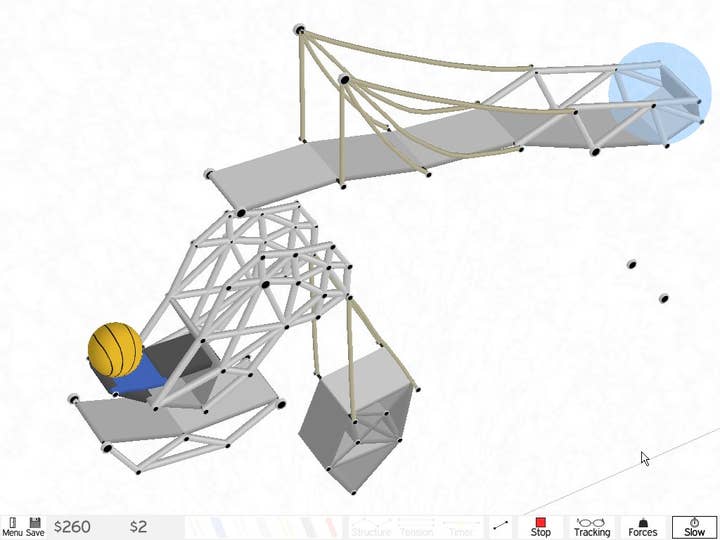The sweet science of Armadillo Run
Why I Love: Hugecalf Studios' Andy Metcalfe explains how the 2008 indie effort got the ball rolling on his love of physics-based puzzlers
Why I Love is a series of guest editorials on GamesIndustry.biz intended to showcase the ways in which game developers appreciate each other's work. This entry was contributed by Andy Metcalfe of Hugecalf Studios, the UK indie studio behind physics-based construction comedy When Ski Lifts Go Wrong, recently published by Curve Digital for the Nintendo Switch and Steam.
Armadillo Run came onto my radar in January 2008. I was 14 at the time and had a big interest in maths and physics already. I'd been messing around with HTML and Flash for around a year at this point -- making basic websites, animations, and 'games' -- although if you saw them, I think you'd agree that calling them games is a big stretch, let's go with interactive... things?
At this time, my only experience with a physics-based game was the old school Bridge Building Game by Alex Austin (Cryptic Sea). Along with my brother, I had spent hours playing every level countless times. We would build and try every solution we could think of from sensible through to stupid, with the result of hours of fun.
I don't recall how I came across Armadillo Run, but after looking at the screenshots I wanted to have a go. I downloaded the free demo, which gave access to the tutorials and the first six levels.

The game made an unforgettable first impression on me. The home screen is a physics simulation in itself, showing off all of the physics features of the game. A fantastic contraption built from rockets, rubber, cloth, elastic, metal and rope -- all arranged to spell out "Armadillo Run" -- sets a sphere with an Armadillo texture down a course to its end goal: an interdimensional portal. Your goal as the player: get poor lost Armadillo to the portal at the end of each level, and help it find a way home.
After playing the first couple of levels I knew I needed this game.
"This game had taken my maths, physics and computer interests, and set them all on fire."
Skip forward a painful week of convincing my mum to let me use her credit card online ("What about the [hackers/scammers/phishers/insert computer criminal term here] Andy?"), and I had bought the full version.
The full version has 50 levels to play, and they get really, really hard. It's incredibly frustrating, but it's even more addictive, so you'll always find the solution to the level. The most frustrating thing about this game is that you don't just need to get Armadillo to the portal, you need to get it to stay within the portal for five seconds. If you leave the portal at any time before five seconds, the timer is cancelled. Cue hair pulling.
And then you go online to look at other people's solutions. If you hadn't already thought about it, you're blown away by the variety of solutions for each level and by the fact that there isn't a "correct" solution to any of the levels.
The developer even threw in a level editor. I know, it's a simple game and having a level editor isn't the most unimaginable thing. But it means once you've completed the levels, you have an endless supply of new levels that you can build or download. You can build massive rockets. You can build mechanisms and machines. It's cheesy, but the only limit is your imagination!
To say I was inspired by this game would be an understatement. This game had taken my maths, physics and computer interests, and set them all on fire.
Over the following years, Armadillo Run was always a game I could go back to. Installing it on new computers as and when they came was no issue because the registration code process was well designed and simple.

Fast forward 10 years from my initial purchase and I'm 1.5 years into my game project. Together with my friend from university and his brother, we're making a physics-based puzzle game (sound familiar already?) called When Ski Lifts Go Wrong (formerly Carried Away).
We've learnt to wrestle with Unity and bend it to our will (just about!) and we have a game that we're all proud off. Apart from one task that has existed since we started, simply titled "deterministic physics". It was (and still is) assigned to me. Deterministic means having predictable results, therefore the result of a deterministic physics simulation will be identical the first time all the way through to the hundredth time you run it and beyond). Unity's 2D physics system is non-deterministic, a lesson we have painfully learnt.
It was at that point I suddenly thought to boot up the old Armadillo Run and see how the physics in that looked. To my amazement, the physics appeared to be identical from one run to the next. How the hell did they do that?!
So I emailed the address on the developer's website. And I'm glad I did. I had a reply in my inbox in less than a day. And it wasn't just a fob-off reply either. It was a very detailed, informative and interested reply stating, as we'd suspected, that he had rolled his own physics engine. We went on to exchange a few emails and I was left feeling great having spoken to another game developer.
So not only did the game Armadillo Run inspire me to become a game developer when I first played it, the developer inspired me to continue 10 years later! And writing this article definitely took way longer than it should have done, as every few sentences I was alt-tabbing into Armadillo Run to play a level. Good job, Peter Stock.
Developers interested in contributing their own Why I Love column are encouraged to reach out to us at news@gamesindustry.biz.